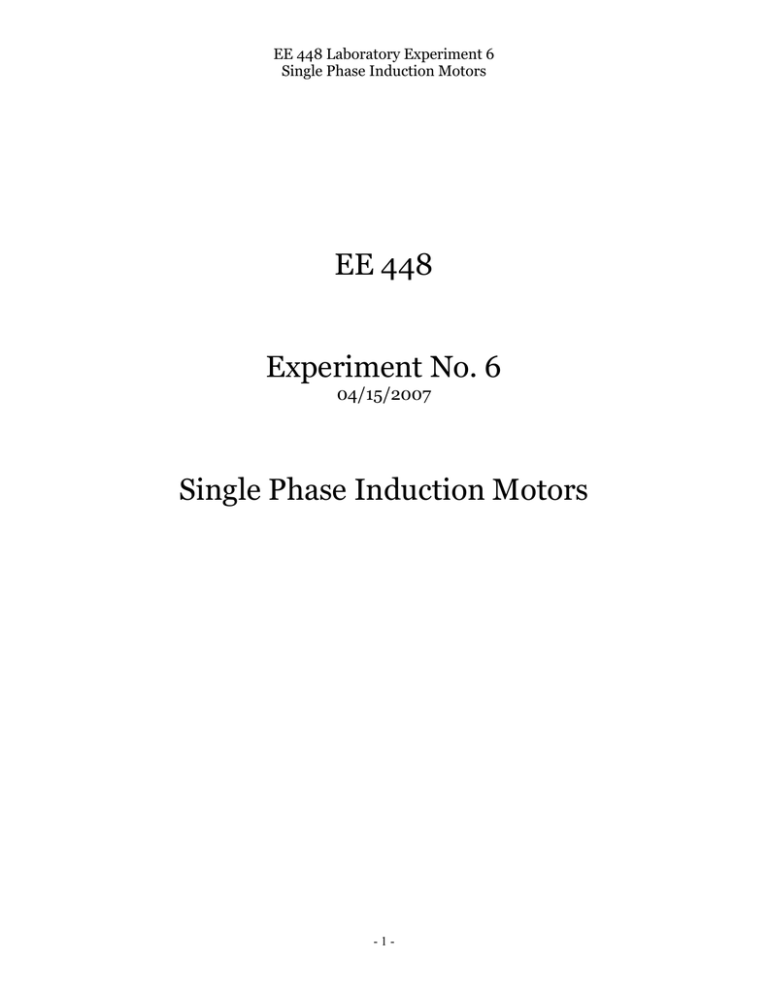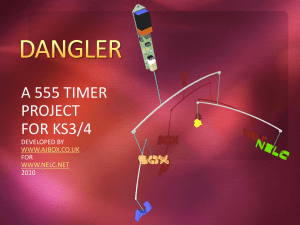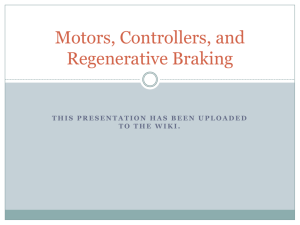EE 448 Experiment No. 6 Single Phase Induction Motors
advertisement

EE 448 Laboratory Experiment 6 Single Phase Induction Motors EE 448 Experiment No. 6 04/15/2007 Single Phase Induction Motors -1- EE 448 Laboratory Experiment 6 Single Phase Induction Motors I. INTRODUCTION The objectives of the experiment are: To examine the construction of the capacitor- run and the capacitor -start motors; To determine their starting and running characteristics; To compare their starting and running performance with each other. INSTRUMENTS AND COMPONENTS: Capacitor Run Motor Module EMS 8253 Split-Phase/Capacitor Start Motor Module EMS 8251 Power Supply Module (120 Vac, 0-120 Vac) EMS 8821 Electrodynamometer Module EMS 8911 AC Metering Module (2.5/8/25A) EMS 8425 AC Metering Module (250 V) EMS 8426 Strobotac Timing Belt EMS 8942 Tachometer Capacitor Start Motor -2- EE 448 Laboratory Experiment 6 Single Phase Induction Motors Capacitor Run Motor Tachometer II. BACKGROUND Single-phase motors are all rather noisy because they vibrate at 120 Hz when operated on- a 60 Hz power line. Various attempts to reduce this noise, such as -3- EE 448 Laboratory Experiment 6 Single Phase Induction Motors resilient rubber mounting, are never totally effective in eliminating this vibration, particularly when the motor is directly coupled to a large resonant-prone fan. The capacitor run motor is very useful in this type of application because the motor can be designed to have low vibration under full-load. The capacitor serves to shift the phase on one of the windings so that the current through the winding is 90 degree phase shifted from the current through the other winding, thus making the capacitor run motor a truly two-phase machine at its rated load. Because the capacitor remains in the circuit at all times no centrifugal switch is required. When running at no-load, the motor is always noisier than at full-load because only under full-load does it run as a true two-phase machine. If the proper value of capacitance is chosen, the power factor can be close to 100% under full load conditions. However, the starting torque is quite low and the capacitor run motor is not recommended for severe starting conditions. In a split-phase motor, the phase difference between start and run winding currents falls far short of 90 degrees. The starting torque developed in a motor that uses a split-phase stator also falls far short of the maximum that can be attained at an ideal 90 degree phase difference. A phase shift closer to the ideal 90 degrees is possible through the capacitor-start system for creating a rotating stator field. This system, a modification of the splitphase system, uses a low reactance capacitor placed in series with the start winding of the stator to provide a phase shift of approximately 90 degrees for the start current resulting in greatly improved starting torque over the standard splitphase system. Capacitor start motors have the same running characteristics as their split-phase counterparts. The capacitor and the start winding are disconnected by a centrifugal switch, just as in the case of the standard split-phase motor. Reversing the direction of rotation of a capacitor start motor is the same as in the case of the split-phase motor, that is, reverse the connections to the start or to the running winding leads to the supply/source. III. PRELAB EXERCISES Fill in the blanks. 1. In a capacitor-start or capacitor-run motor, a capacitor is placed in series with _________ winding of the motor to provide ________ torque. 2. In the capacitor-start motor, the capacitor is disconnected by the _________ switch. -4- EE 448 Laboratory Experiment 6 Single Phase Induction Motors Answer the following questions. 3. How can the direction of rotation of a split-phase or capacitor-start induction motor be reversed? 4. Compare capacitor start and capacitor run motor with respect to (i) starting torque, (ii) power factor at rated speed. (Answer either high or low.) Starting Torque Capacitor start__________ Capacitor run__________ 5. Starting current and starting torque of a capacitor start motor are 8A and 4 lb-in. respectively for an applied voltage of 60 V (Assume current is linearly related to voltage). What is the starting current and starting torque at 120 V. Starting Torque Starting Current At 60V 4 lb-in 8A At 120V _____ _____ IV. LABORATORY EXPERIMENTS CAUTION: HIGH VOLTAGES ARE PRESENT IN THIS LABORATORY EXPERIMENT! DO NOT MAKE ANY CONNECTIONS WITH THE POWER ON! THE POWER SHOULD BE TURNED OFF BEFORE THE CIRCUIT IS MODIFIED! A. CAPACITOR RUN MOTOR 1. a. Remove the Capacitor Run Motor Module EMS 8253, from the work station and examine the construction, paying particular attention to the motor, capacitor, connection terminals and the wiring. b. Record the nameplate rating HP _____, Speed _____, Current _____, Voltage _____ . c. Calculate the rated torque __________ lb.in. 2. Using your EMS Capacitor Run Motor, Power Supply, Power transducer, -5- EE 448 Laboratory Experiment 6 Single Phase Induction Motors Electro dynamometer and AC Metering Modules, connect the circuit shown in Fig. 1. a. Couple the electrodynamometer to the capacitor run motor with the timing belt. (Leave the belt off for the zero torque setting in part 3.) b. Connect the input terminals of the electrodynamometer to the fixed 120 Vac output of the power supply, terminals 1 and N. c. Set the dynamometer control knob at its full ccw position (to provide a minimum starting load for the capacitor run motor). 3. a. Turn on the power supply and adjust for 1 20 Vac. b. Measure and record in Table 1 the line current, the power and motor speed for each torque listed in Table 1. Capacitor Run Motor W1 4 4 + - Ammeter 8 Amp - - - + Wattmeter - I1 + 120 Volt Voltage Variable AC Source 8821 + - V1 Voltmeter Main N 1 2 - 5 - Auxilary 3 1 1 Electro-Dynamometer 120 V AC Source 8821 N - Figure: 1 Capacitor run motor connection diagram Table 1. Capacitor run motor measurements V Torque (volts) (lbf-in) 120 0 120 3 120 6 120 9 I (amps) S (va) P (watts) -6- Speed Output (hp) (r/min) eff (%) p.f. (% *) 4 C 6 EE 448 Laboratory Experiment 6 Single Phase Induction Motors 4. a. Calculate and record in Table 1 the apparent power delivered to the motor, the developed horsepower, the efficiency, and the power factor for each of the listed torques. b. Place ammeters properly in the circuit and measure at rated torque current in the main field winding __________ current in the auxiliary field winding __________ c. At the rated torque measure, calculate and record in Table 2 the values requested for each of the voltages listed. Table 2 V (volts) 125 120 115 I (amps) S (va) P (watts) Speed (r/min) Output (hp) eff (%) p.f. (%) 5. You will now determine the maximum starting torque developed by motor and its starting current. a. Disconnect the wattmeter from your circuit and change the range of the ammeter from 8 to 25A. b. Set the dynamometer control knob to its full cw position (for maximum loading). c. Close the power supply switch. Rapidly, but steadily increase the supply variac to 120 volts and measure the developed torque on the dynamometer scale and the starting current. Open the power supply switch as soon as possible. Starting Torque = ____________ lb.in Starting Current = ____________ Aac B. CAPACITOR START MOTOR 1. Using your EMS Split-Phase/Capacitor Start Motor, Power Supply and AC Metering Modules, connect the circuit shown in Fig. 2. Note that the variable 120 Vac output of the power supply, terminals 4 and N are -7- EE 448 Laboratory Experiment 6 Single Phase Induction Motors being used. Capacitor Start Motor 4 + 4 + + Ammeter 25 Amp - + 60 Volt Voltage Variable AC Source 8821 I1 V1 Voltmeter 2 6 7 - 1 - Centrifugal Switch Main N Auxilary 3 4 C 5 Figure 2: Main winding starting current connection diagram 2. Close the power supply switch, rapidly adjust the voltage to 60 v and measure the current through the main winding as quickly as possible. Shut off the supply as soon as the reading can be made. Imain winding = ______________ Aac (at 60 volts) Assuming current increases linearly, what would the current in the windings be with 120 volts across them? ____________ Aac (120 volts) 3. a. Disconnect the leads from the main winding and connect them to the auxiliary winding and capacitor, as shown in Fig. 3. b. Repeat Procedure 2. Remember to take your measurement as quickly as possible. Iaux winding = ___________ Aac (at 60 volts) Assuming current increases linearly, what would the current in the windings be with 120 volts across them? ___________ Aac (120 volts) -8- EE 448 Laboratory Experiment 6 Single Phase Induction Motors Capacitor Start Motor + 4 + + Ammeter 25 Amp - + 4 I1 V1 Voltmeter N 1 - Centrifugal Switch Main 2 6 7 - 60 Volt Voltage Variable AC Source 8821 Auxilary 3 C 4 5 Figure 3: Auxiliary winding starting current connection diagram 4. a. Connect both windings in parallel, terminals 1 to 3 and 2 to 5, as shown in Fig. 4. Note that the variable supply, terminals 4 and N are being used. Capacitor Start Motor 4 + 4 + + Ammeter 25 Amp - + 60 Volt Voltage Variable AC Source 8821 I1 V1 Voltmeter N Centrifugal Switch - - Main 1 2 6 7 Auxilary C 3 1 1 4 5 Electro-Dynamometer 120 V AC Source 8821 - N Figure 4: Capacitor start motor starting connection diagram b. Couple the electrodynamometer to the capacitor start motor with the timing belt. c. Connect the input terminals of the electrodynamometer to the fixed 120 Vac output of the power supply, terminals 1 and N. d. Set the dynamometer control knob at its full cw position to provide a maximum starting load for the capacitor start motor. -9- EE 448 Laboratory Experiment 6 Single Phase Induction Motors e. Close the power supply switch. Rapidly, but steadily increase the supply variac to 60 volts. Measure the starting current and torque as quickly as possible, then immediately shut off the supply. Istarting = _______________ Aac (at 60 volts) Assuming current increases linearly, what would the current in the windings be with 120 volts across them? _______________ Aac (calculated for 120 volts) Starting torque = ___________ lb.in (at 60 volts) 5. Using the wattmeter, Electrodynamometer and AC Metering Modules, connect the circuit shown in Fig. 5. (Leave the belt off for the zero torque setting in part 7.) Note that the module is wired as a standard capacitor start motor. 6. Set the dynamometer control knob at its full ccw position to provide minimum starting torque for the capacitor start motor. Capacitor Start Motor W1 + + - Ammeter 8 Amp - - - + Wattmeter - I1 + 4 4 - V1 Voltmeter N Centrifugal Switch Main - - 120 Volt Voltage Variable AC Source 8821 1 2 Auxilary 3 1 1 4 Electro-Dynamometer 120 V AC Source 8821 N - Fig. 5 Capacitor start motor connection diagram 7. a. Turn on the power supply and adjust for 120 Vac b. Measure and record in Table 3 the line current, the power and motor - 10 - 6 7 C 5 EE 448 Laboratory Experiment 6 Single Phase Induction Motors speed. c. Repeat (b) for each of the torques listed in Table 3. d. Return the voltage to zero and turn off the power supply. Table 3 V (volts) 120 120 120 120 120 Torque (lb-in) 0 3 6 9 12 I S (amps) (va) P Speed Output (watts) (r/min) (hp) eff (%) p.f. (%) 8. a. Calculate and record in Table 3 the apparent power (S) delivered to the motor, the developed horsepower, the efficiency and the power factor for each of the listed torques. b. Calculate the rated torque for the Capacitor Start motor using the data from the nameplate. Rated torque __________ lb.in. c. At rated torque measure, calculate and record in Table 4 the values requested for each of the voltages listed. Table 4 V (volts) 125 120 115 110 105 I (amps) S (Va) P (watts) - 11 - Speed (r/min) Output (hp) eff (%) p.f. (%)
![Sample_hold[1]](http://s2.studylib.net/store/data/005360237_1-66a09447be9ffd6ace4f3f67c2fef5c7-300x300.png)







